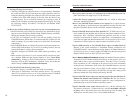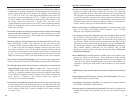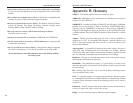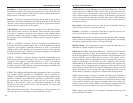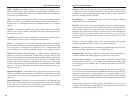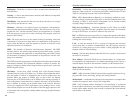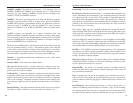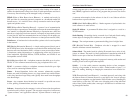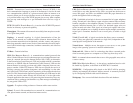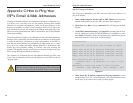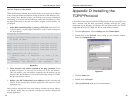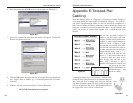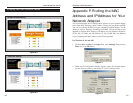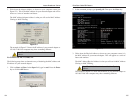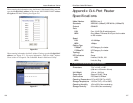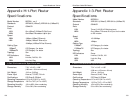
EtherFast
®
Cable/DSL Routers
URL (Uniform Resource Locator) - The address that defines the route to a file
on the Web or any other Internet facility. URLs are typed into the browser to
access Web pages, and URLs are embedded within the pages themselves to
provide the hypertext links to other pages.
UTP - Unshielded twisted pair is the most common kind of copper telephone
wiring. Twisted pair is the ordinary copper wire that connects home and many
business computers to the telephone company. To reduce crosstalk or electro-
magnetic induction between pairs of wires, two insulated copper wires are
twisted around each other. Each signal on twisted pair requires both wires.
Since some telephone sets or desktop locations require multiple connections,
twisted pair is sometimes installed in two or more pairs, all within a single
cable.
VLAN (Virtual LAN) - A logical association that allows users to communi-
cate as if they were physically connected to a single LAN, independent of the
actual physical configuration of the network.
Virtual Server - Multiple servers that appear as one server, or one system
image, to the operating system or for network administration.
Wake-on-LAN - Wake on LAN is a technology that allows a network profes-
sional to remotely power on a computer or to wake it up from sleep mode.
WA N - A communications network that covers a wide geographic area, such as
a state or country.
WEP (Wired Equivalent Privacy) - A data privacy mechanism based on a 64-
bit shared key algorithm, as described in the IEEE 802.11 standard.
WINIPCFG - Configuration utility based on the Win32 API for querying,
defining, and managing IP addresses within a network. A commonly used util-
ity for configuring networks with static IP addresses.
Workgroup - Two or more individuals that share files and databases.
95
Instant Broadband
™
Series
TCP/IP - Transmission Control Protocol/Internet Protocol (TCP/IP) is the
basic communication language or protocol of the Internet. It can also be used
as a communications protocol in a private network (either an intranet or an
extranet). When you are set up with direct access to the Internet, your comput-
er is provided with a copy of the TCP/IP program just as every other computer
that you may send messages to or get information from also has a copy of
TCP/IP.
TFTP (Trivial File Transfer Protocol) - A version of the TCP/IP FTP protocol
that has no directory or password capability.
Throughput - The amount of data moved successfully from one place to anoth-
er in a given time period.
Topology - A network’s topology is a logical characterization of how the
devices on the network are connected and the distances between them. The
most common network devices include hubs, switches, routers, and gateways.
Most large networks contain several levels of interconnection, the most impor-
tant of which include edge connections, backbone connections, and wide-area
connections.
TX Rate – Transmission Rate.
UDP (User Datagram Protocol) - A communications method (protocol) that
offers a limited amount of service when messages are exchanged between com-
puters in a network that uses the Internet Protocol (IP). UDP is an alternative
to the Transmission Control Protocol (TCP) and, together with IP, is sometimes
referred to as UDP/IP. Like the Transmission Control Protocol, UDP uses the
Internet Protocol to actually get a data unit (called a datagram) from one com-
puter to another. Unlike TCP, however, UDP does not provide the service of
dividing a message into packets (datagrams) and reassembling it at the other
end. Specifically, UDP doesn't provide sequencing of the packets that the data
arrives in. This means that the application program that uses UDP must be able
to make sure that the entire message has arrived and is in the right order.
Network applications that want to save processing time because they have very
small data units to exchange (and therefore very little message reassembling to
do) may prefer UDP to TCP.
Upgrade - To replace existing software or firmware with a newer version.
Upload - To send a file transmitted over a network. In a communications ses-
sion, upload means transmit, and download means receive.
94



